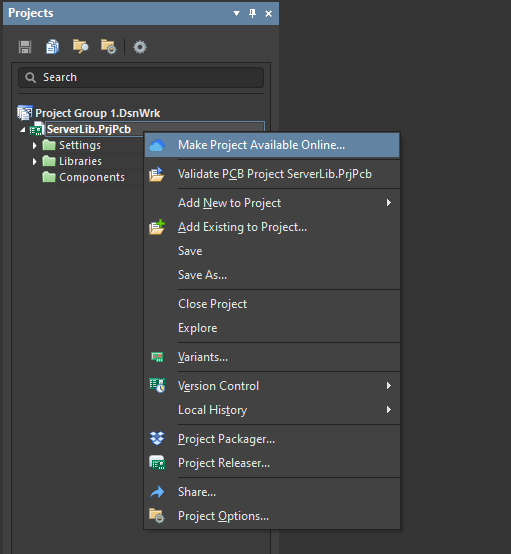Unlink a PCB Project
Your design data is valuable and you must protect it. Altium’s managed sharing features are essential. But what if you need to reclaim a project and remove it from the cloud? While you could go through a process of manually downloading a project from version control, replicating the file structure, and deleting the online version, there is a more straightforward way to do this, which gives you greater flexibility.
You can quickly unlink a project from your Altium workspace and keep its contents in your local machine. It is your choice whether you want to continue storing the project in your cloud workspaceY you can still grab design data from your repository if you need it, or simply delete it from your workspace.
Unlink a Project from the Cloud
To get started with unlinking a project from the cloud, first open the project in Altium Designer. Connect to your workspace and open the project. You can find your project files in one of the following locations:
- The original project location on your local machine. If you created the project, the design files download back to that original location.
- The default Projects folder you’ve set up for Altium Designer. If someone else created the project, the project files (including folder structure) are imported into the default Projects folder on your local machine.
If you’re ever unsure of the project file’s location, simply right click on the .PcbPrj file in the Projects panel and click Explore to display the design data’s path on your local computer. You can then select these files and copy them somewhere else on your machine. Once you’ve gathered the design data into a safe location, you can then unlink the project from your Altium cloud workspace.
Time to Unlink
With the project still open in Altium Designer, right click on the .PcbPrj file in the Projects panel and click Project Options. From the dialog box, you can click Turn Off Synchronization. A verification dialog will come up, where you can unlink the project from your Altium workspace.
Once you confirm the unlink operation, right-click on your .PcbPrj file in the Projects panel and click Save. By performing the “unlink” operation, we’ve created a local copy of the project, which can then be opened directly from your local machine just like any other project. The project will now appear as a local project in the Projects panel.
Although you’ve unlinked a project from your Altium Workspace, what you’ve done is you’ve removed it from online version control. The version control for the project will shift back to version control on your local machine. If you want to delete your project altogether, you need to go a step further.
Unlink vs. Delete
Unlinking a project is not the same as deleting a project. To delete a project and remove access, you need to delete your data. If you’re using the cloud platform, bring up the web instance and navigate to the projects folder. In the image below, you’ll notice that the project we want to unlink is still visible in the main Projects folder.
The image above shows how to remove a project from your cloud workspace through the web interface. You can do the same through the Explorer Panel in Altium Designer. To remove the project entirely, right-click on the project and click Remove. Once the project is removed, it will be inaccessible to anyone (including you!).
An alternative is to leave the project in your cloud workspace and remove access to the project for everyone else. This can be problematic depending on user roles and permissions for people in your Workspace.
Full Circle: Putting an unlinked PCB Project Back on the Cloud
Suppose you need to put the project back into your Workspace to continue collaborating or to create a variant. Making your project available online is a simple process and can be done directly from the Projects panel. Bring up your local project, then right-click on the project and click “Make Project Available Online…"
After you click through this dialog, you’ve just placed your project back into Altium version control. The project will populate in your Altium cloud workspace, which you and others can view through the Explorer panel in Altium Designer or the cloud workspace.
You can now share the project with other collaborators, manufacturers, or customers as needed. You can also clone the project within your workspace, create a project variant with other designers, and unlink the original project after cloning. You’ll control how your designs are accessed and tracked, and they will evolve with sharing and collaboration in Altium.







